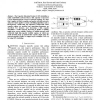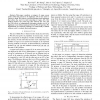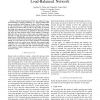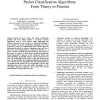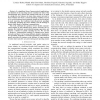INFOCOM
2009
IEEE
15 years 7 months ago
2009
IEEE
—The typical state-of-the-art routing algorithms for delay tolerant networks are based on best next hop hill-climbing heuristics in order to achieve throughput and efficiency. T...
INFOCOM
2009
IEEE
15 years 7 months ago
2009
IEEE
— The Capacity Allocation Paradox (CAP) destabilizes a stable small-buffer network when a link capacity is increased. CAP is demonstrated in a basic 2x1 network topology. We show...
INFOCOM
2009
IEEE
15 years 7 months ago
2009
IEEE
—This paper considers a category of rogue access points (APs) that pretend to be legitimate APs to lure users to connect to them. We propose a practical timing based technique th...
105
click to vote
INFOCOM
2009
IEEE
15 years 7 months ago
2009
IEEE
—Valiant load balancing (VLB), also called two-stage load balancing, is gaining popularity as a routing scheme that can serve arbitrary traffic matrices. To date, VLB network de...
131
click to vote
INFOCOM
2009
IEEE
15 years 7 months ago
2009
IEEE
Abstract—Network coding is emerging as a promising alternative to traditional content distribution approaches in P2P networks. By allowing information mixture in peers, it simpli...
113
click to vote
INFOCOM
2009
IEEE
15 years 7 months ago
2009
IEEE
—During the past decade, the packet classification problem has been widely studied to accelerate network applications such as access control, traffic engineering and intrusion de...
97
Voted
INFOCOM
2009
IEEE
15 years 7 months ago
2009
IEEE
—In this paper, we describe and analyze the design of a joint Transport, Routing and Spectrum Sharing (TRSS) optimization algorithm for wireless networks with frequencyagile radi...
INFOCOM
2009
IEEE
15 years 7 months ago
2009
IEEE
—In a significant class of sensor-network applications, the identities of the reporting sensors constitute the bulk of the communicated data, whereas the message itself can be a...
INFOCOM
2009
IEEE
15 years 7 months ago
2009
IEEE
103
click to vote
INFOCOM
2009
IEEE
15 years 7 months ago
2009
IEEE
Abstract—Different geographic routing protocols have different requirements on routing metric designs to ensure proper operation. Combining a wrong type of routing metric with a ...

